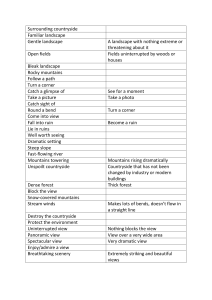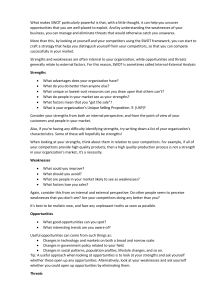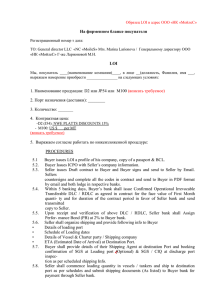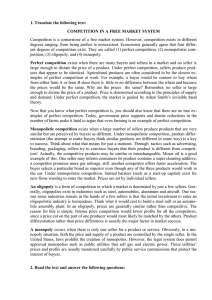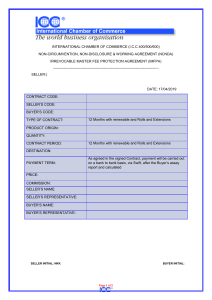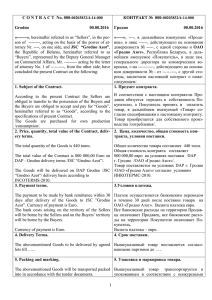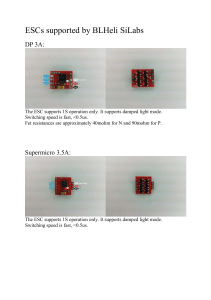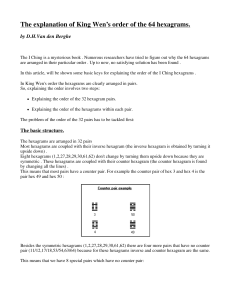
COMPETITIVE STRATEGY (2017-2018) MAPPING THE BUSINESS LANDSCAPE BUSINESS LANDSCAPE METAPHORE Most businesses operate in a highdimension space of choices. Thinking of a three-dimensional business landscape each location S would represent a different strategy (a different set of choices). S A Business Landscape maps each stategy’s elevation according to its economic profitability. The goal of a strategy is to guide a business to a relatively high point on such a landscape. BUSINESS LANDSCAPE Managers would need to understand the business landscape in which their firms operate in order to: • decide where and how their firms will compete; • assess the implications of major changes in the business landscape; • adapt to the business landscape; shape the business landscape. • We will describe various structures corresponding to various different ways of thinking of the business landscape: ➢ The SUPPLY- DEMAND ANALYSIS ➢ BENCHMARKING ➢ The SWOT ANALYSIS ➢ The ‘FIVE FORCES’ FRAMEWORK ➢ The VALUE NET SUPPLY-DEMAND ANALYSIS The supply-demand analysis has long been known (Middle Ages) in western culture. Formalisation by Alfred Marshall (1842-1924) in the SD diagram: the equilibrium price of a given good is determined at the point where the aggregated demand curve for that good intersects the correspondent aggregated supply curve. The S-D analysis is deeply rooted in sometimes highly unrealistic assumptions: - Large numbers of suppliers - Product homogeneity Other frameworks: Monopoly and Duopoly (Cournot, 1838), Monopolistic competition (Chamberlin and Robinson, 1933), Oligopolistic competition - i.e. ‘competition among few’ – (Hotelling, 1929) BENCHMARKING The idea that comparing your own business to a rival is essential when competing dates back to the 1800s and became a valuable and widely used tool of management in the late 1980s, formally introduced by Xerox. Main purposes of benchmarking are: • Improve company’s performance by means of the identification of best practices in other companies that is possible to apply to own processes. • Reveal successful business processes by observing and scrutinizing rival companies’ processes, skills or competences. • Facilitate knowledge sharing when knowledge acquired from rivals can be transferred to own company. • Gain competitive advantage applying best practices from other industries to own industry. BENCHMARKING There are different types and approaches to benchmarking. Three major types: • Strategic benchmarking Identifies winning strategies that successful companies use and compare strategic goals to spot new strategic choices. • Performance benchmarking Determines how strong own products and services are compared to those of competitors by looking at some features like price, reliability, design and customer satisfaction. • Process benchmarking It is usually derived from performance benchmarking and it looks at companies engaging in similar activities to identify best practices that can be applied to own processes. BENCHMARKING Each type of benchmarking may be carried out following one of the different approaches: • Internal benchmarking Usually employed by organisations operating in different geographic locations/different product markets that have not yet developed a knowledge sharing system between divisions. • External/Competitive benchmarking External is often opposed to Competitive to refer to comparison with competitors outside own industry. • Functional benchmarking The comparison here takes place at the level of functional departments only (marketing, finance, human resources, etc.). The advantage is that companies may look at a wider range of organisations, even unrelated ones, in their search for best practices. • Generic benchmarking Takes place when the comparison is between own company and some generally accepted best standards. SWOT ANALYSIS Developed in the 1960’s, the SWOT analysis is useful in identifying and understanding key issues affecting a specified business objective (can be carried out for a product, a project, a business, even an entire industry). The idea is that the company determines its strategic fit given its internal capabilities and external environment in a two-by-two grid. Limitations: EXTERNAL FACTORS I N T E R N A L F A C T O R S - It does not provide any guidance on how to identify the four elements; - It offers a preliminary stage in strategic planning and does not provide solutions immediately; - It may generate too many ideas/information without prioritising among them. ‘FIVE FORCES’ FRAMEWORK Michael E. Porter (born 1947, professor at HBS) Published Competitive Strategy in 1980, where he presented a framework for industry analysis with the purpose of relating the average profitability of participants in a given industry to five competitive forces. ‘FIVE FORCES’ FRAMEWORK 1. THE DEGREE OF RIVARLY: it is the most obvious competitive force determining the attractiveness of an industry. Its major determinants are: Number and relative size of competitors The more concentrated the industry, the less rivalry; the presence of a dominant player may lessen rivalry by setting industry prices and disciplining defectors. Industry basic conditions High fixed costs, excess capacity, slow growth and lack of product differentiation all increase the degree of rivalry in an industry. Behavioural determinants If competitors are diverse, face high exit barriers, or attach high strategic value to their position in the industry, they are more likely to compete aggressively. ‘FIVE FORCES’ FRAMEWORK 2. THE THREAT OF ENTRY: industry profitability is also influenced by potential competitors. Entry Barriers may take on several forms: Structural (or natural) entry barriers including: ▪ ▪ ▪ ▪ Economies of scale/scope Network effects Ownership or control of key scarce resources High set-up costs ( sunk costs, R&D costs, etc.) Strategic (or artificial) entry barriers including: ▪ ▪ ▪ ▪ ▪ Predatory pricing Limit pricing Predatory acquisition Switching costs Advertising ▪ ▪ ▪ ▪ ▪ Strong brand Loyalty schemes Exclusive contracts Patents and licensing Vertical integration ‘FIVE FORCES’ FRAMEWORK 3. THE THREAT OF SUBSTITUTES: concerns all different ways of performing similar functions for customer, not just physically similar product (e.g. airlines vs. rental automobile and high speed train, but also vs. videoconferencing). The threat is determined by: Relative price performance of substitutes Switching costs Buyer propensity to substitute ‘FIVE FORCES’ FRAMEWORK 4. BUYER POWER: the ability of buyers to squeeze industry margins. Among its determinants we find ▪ ▪ ▪ Buyers concentration Buyer volume Buyer information ▪ ▪ ▪ Switching costs Product differences Etc. When considering the buyer power, two other factors need to be addressed: The buyer’s willingness or incentive to use their inherent power The perceived risk of failure associated with a products’ use ‘FIVE FORCES’ FRAMEWORK 5. SUPPLIER POWER: the bargaining power of industry suppliers’ may depend on ▪ ▪ ▪ ▪ ▪ Supplier concentration Supplier size Differentiation in inputs Presence of substitute inputs etc. Think of the potential damage that a service disruption in the airline industry may cause following a strike organised by Trade Union. This consideration may help understand why pilots and aviation mechanics have been historically able to obtain wages and benefits to levels well in excess of other industries. ‘FIVE FORCES’ FRAMEWORK CRITICISMS There are at least three dubious assumptions underlying the five forces model by Porter: • Buyers, competitors, and suppliers are unrelated as the possibility of interactions and collusion are not explicitly considered. • The main determinant of value in the model basically rely on the creation of structural advantage (the creation of entry barriers). • Uncertainty is low and the model allows participants in a given market to plan for and respond to competitive behaviour. THE ‘VALUE NET’ In 1996, Branderburger (Harvard) and Nalebuff (Yale) generalised the concepts introduced by Porter’s ‘five forces’ Model developing the ‘VALUE NET’ framework. The value net focuses on the critical role of COMPLEMENTORS: ➢ On the demand side, complementors increase buyers’ willingness to pay (WTP) for products. ➢ On the supply side, complementors decrease the price that suppliers require for their inputs. THE ‘VALUE NET’ THE INTUITION • In Porter’s model firms compete for ‘slices of one pie’ (zero-sum game). • While a competitor generally takes suppliers/buyers away from your pie, a complementor adds suppliers/customers to the pie. • Cooperation with complementors is expected to expand the size of the pie, while there is still competition with them for sharing of the pie (coopetition). THE ‘VALUE NET’ THE ‘VALUE NET’ How to assess the relative bargaining power of complementors? Relative concentration Relative buyer/supplier switching costs Relative complementor/competitor switching costs Asymmetric integration threats Rate of growth of the pie THE ‘VALUE NET’ RELATIVE CONCENTRATION The more concentrated complementors are relative to competitors, the higher their bargaining power. The more fragmented complementors are relative to competitors, the lower their bargaining power. Examples: • In 1993, Chipmaker Advanced Micro Devices Inc.’s (AMD) signed a US$3-billion deal to build Xbox One (owned by Ms) chips. • In 2005, Steve Jobs announced that Apple would begin producing Intel-based computer beginning in 2006. THE ‘VALUE NET’ RELATIVE BUYER / SUPPLIER SWITCHING COSTS The higher the costs of switching across complementors relative to the costs of switching across competitors, the higher the complementors’ bargaining power. Examples: • The cost of switching software on a PC is typically higher than the cost of switching the Internet service provider on that PC. more bargaining power for software providers. • The cost of switching operative systems on a computer is generally higher than the cost of switching application programs this is why these are purchased independently. THE ‘VALUE NET’ … do like the experts do . . . THE ‘VALUE NET’ RELATIVE COMPLEMENTOR / COMPETITOR SWITCHING COSTS If complementors play a significant role in pulling demand or supply, their power is likely to extend. Examples: • In 1991 Intel debuted with the campaign ‘Intel Inside’ that created a strong brand out of something so far perceived as a mere ingredient, a chip, at a time when ingredient branding was unheard of. • The advertising results were stunning. In 1991, Intel research indicated that only 24% of European PC buyers were familiar with the Intel Inside® logos. One year later that figure had grown to nearly 80% and by 1995 it had soared to 94% and continues at these high levels today. This was a clear example of a complementor (Intel) trying to build an independent appeal to buyers. THE ‘VALUE NET’ ASYMMETRIC INTEGRATION THREATS Complementors gain more power when can threaten to invade competitors’ terrain more credibly than competitors can threaten to invade theirs Example: • Intel’s forward integration into motherboards when PC manufacturers do not seem to have any offsetting backward integration options. THE ‘VALUE NET’ RATE OF GROWTH OF THE PIE Competition with complementors is be less intense when the size available pie to be divided competitors and complementors is rapidly. likely to of the among growing Example: • When Microsoft unveiled its Surface Tablets in 2012, intel executives were shocked as they were not notified and did not play any role in the announcement, despite the fact that the tablets used Intel chips. • Microsoft decision was one of the cracks in the so-called ‘Wintel alliance’ between the two giant industries and it is related to the maturing of demand for personal computers. THE ‘VALUE NET’ The lessons The lesson to learn from the ‘value net’ framework is NOT the one of trying to minimize complementors’ bargaining power per se, in any situation But rather … Introducing into the analysis a new type of players, the ‘complementors’, and understand how their presence shape the business landscape, and how it may represent a threat and/or an opportunity for our business. Example: • Microsoft was able to beat Apple over an extended period of time, despite not having superior operating systems, just because it encouraged independent software vendors to develop software to run on its platform. MAPPING THE BUSINESS LANDSCAPE From mapping the business landscape to strategic planning and action Once we know the business landscape where we operate in, we need to incorporate this analysis into strategic action. This can be done with the following six-step process (that may be cycled-through more than once): 1. Gathering information 2. Drawing the boundaries 3. Identifying groups of players 4. Understanding group-level bargaining power 5. Thinking dynamically 6. Shaping the business landscape MAPPING THE BUSINESS LANDSCAPE 1. Gathering information • Industry studies • Company sources • Government sources • Business press • Other WWW sources (blogs, business stories, etc.) • Business info databases (‘Dun & Bradstreet’, ‘Thomas Register’, CRIF, etc.) • Other (conferences, keynote speeches, trade shows, etc.) MAPPING THE BUSINESS LANDSCAPE 2. Drawing the boundaries The strategist needs to chose the INDUSTRY DEFINITION, meaning that he needs to decide how broadly/narrowly to draw the boundaries. ➢ Horizontal scope – the boundaries of the landscape should be drawn a bit more broadly to include not only the segments that the business serves, but also unserved segments with which it shares customers and technology (competitors) and complements. ➢ Vertical scope – attains to the choice of how many vertically linked stages of the supplier/buyer chain to consider. If a competitive market for third-party sales exists between vertical stages (or could be created), the stages should be analysed separately, o/w they can be merged. ➢ Geographical scope – how broadly to define the business landscape in terms of physical locations covered? Key to answering the question are the degree of geographical market integration and the type of decision at stake. IMPORTANT REMARK: it is, generally, more useful to focus on ensuring that the boundaries are drawn clearly and that there is consistency in treatment of what is IN vs. what is OUT, instead of looking for the ‘right way’ of drawing boundaries. MAPPING THE BUSINESS LANDSCAPE 3. Identifying groups of players Make sure you identify the main groups of players: - Competitors Potential entrants Substitutes Complements - Buyers - Suppliers - Etc. It is also important to distinguish within the groups when sub-groups show substantial differences in bargaining power (e.g. labour within the group suppliers). MAPPING THE BUSINESS LANDSCAPE 4. Understanding group-level bargaining power This is, probably, the core objective in the attempt to map the business landscape. ➢ Concentrate on (sub)groups with particular potential to influence a business’ payoff (do not insist on looking at all groups in equal depth). ➢ Extension of the analysis to other groups of players such as governments or non-profit organisations requires some modifications to the basic approach outlined. ➢ This phase is usually accompanied and supported by a cross-checking of the hypotheses using data on average profitability of players. MAPPING THE BUSINESS LANDSCAPE 5. Thinking dynamically ➢ You want to understand the business landscape AS IT WILL BE rather than as it is or as it was. Case: IBM/Microsoft (from “The dumbest moments in business history…”, 2004). ➢ Use different time horizons: • short-run – to keep track of industry and economy-wide business cycle. • long-run – to capture trends such as market growth, the evolution of buyers need, the rate of innovation, required changes in scale, input costs. ➢ Do not forget discontinuities and shocks: differently from business cycles, they lead to a resetting of the structure itself. MAPPING THE BUSINESS LANDSCAPE 6. Shaping the business landscape USING KNOWLEDGE FOR STRATEGIC ACTION • Anticipating long-run performance (removing the effect of business cycles). • Identifying groups of players/forces that must be countered to achieve good performance. • Testing decisions to enter, invest in, or exit from an industry. • Assessing the effects of a major change in the business landscape to respond to it. • Identifying ways to shape the business landscape. ‘To know’ To know Be sure that, by the end of this module, you are able to illustrate: • • • • • • • • • • • The business landscape metaphor. The supply-demand analysis and its limitations. The different types and approaches to benchmarking. The SWOT analysis and its limitations. The ‘five forces’ framework and its limitations. The main determinants of the ‘five forces’. The different types of ‘entry barriers’. The ‘value net’ framework and its limitations. The concept of co-opetition and its insights. How to assess the relative bargaining power of complementors. The landscape analysis, its phases, insights and limitations. Glossary Glossary: • • • • • • • • • • Benchmarking Business landscape Complementors Co-opetition Demand/supply curve Dynamic thinking Entry barriers ‘Five forces’ framework Geographical scope Horizontal scope • • • • • • • • • • • Non-market relationships Price-elasticity of demand Product homogeneity Purchasing power Strategic groups Strategic fit Substitutes Supply-demand analysis Switching costs Value net Vertical scope
